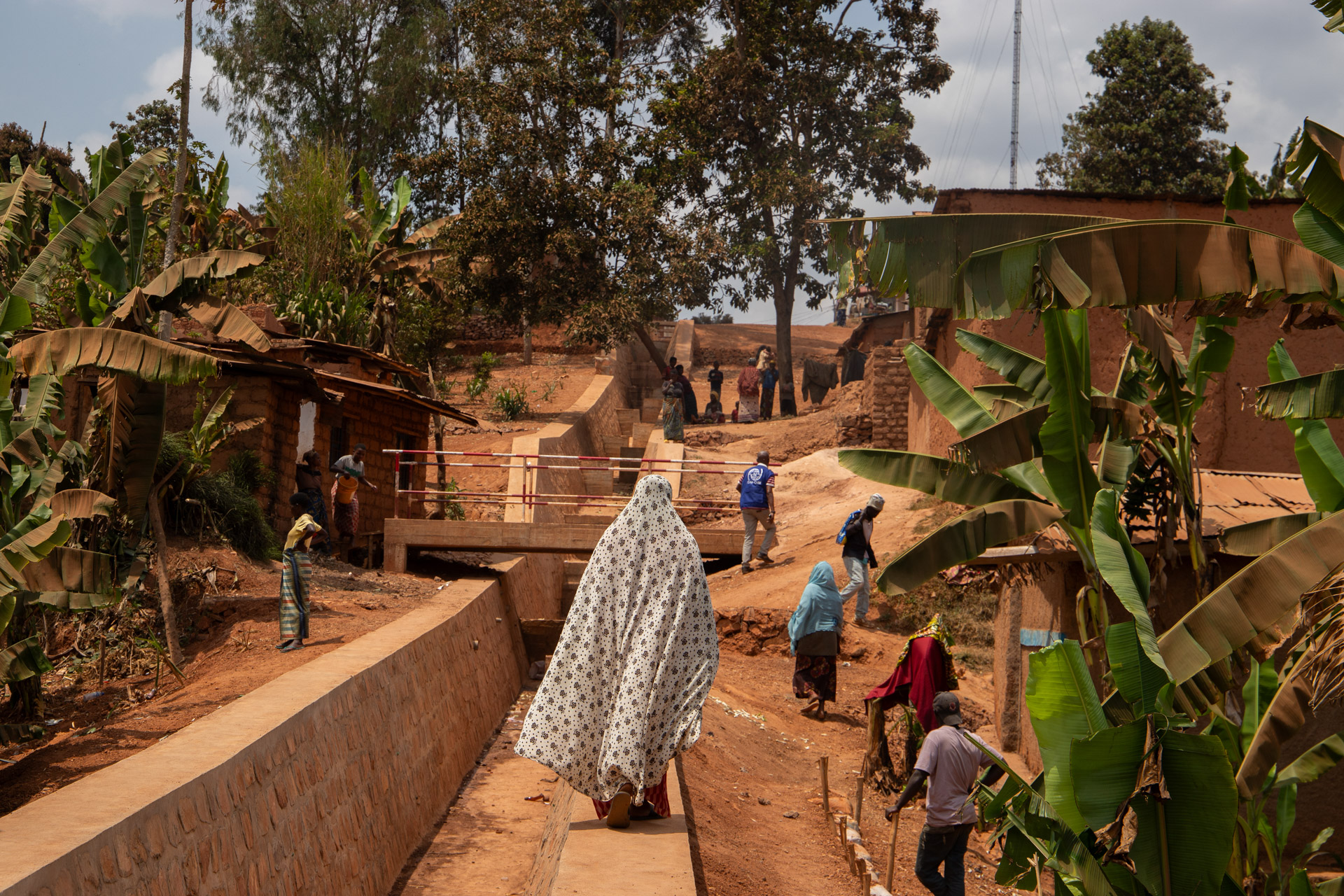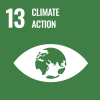Burundi’s progress for resolving, preventing and addressing the displacement crisis is remarkable, yet accelerated actions are needed to reach the country’s SDG commitments.
Nyamugari, 11 September 2023 – In the rural village of Nyamugari in central Burundi, houses are built on a steep hillside. They used to be divided in two separate sections by a steadily growing 13-meter-deep ravine. Several households recall living in fear of seeing their young children fall and being swept away by the water stream passing through the ravine that always becomes vicious during the rainy season.
“We wanted to leave this place,” states Leticia Kivuto, a resident in one of the houses nearing the edge of the ravine for over 30 years. “We were only stopped from doing so by poverty, because we had no means and nowhere to go to. Many families were in the same position.”
As among the 20 most vulnerable countries to climate change and in a context where climate-induced disasters are found to be the cause of almost 90 per cent of internal displacement, Burundi is regularly hit by a variety of hazards, including stormy winds, torrential rains, landslides and flooding along Lake Tanganyika. The country must also cope with slower-onset climatic events, such as drought and soil degradation and erosion, which are just as dangerous for the population's well-being and development.
Because of the extent of the risks for Nyamugari’s residents but also the downstream crops, the rehabilitation of the dangerous ravine into a fortified gutter was identified as a priority mitigation activity by Leticia and her fellow villagers and carried out through a Cash-for-Work programme – a modality of assistance that provides cash to selected individuals directly for their participation in activities that benefit the whole community.
At this unique time when the international community faces a confluence of crises and profound global transformations, the 2023 Sustainable Development Goal (SDG) Summit in New York (18-19 September) ought to be a moment of truth and reckoning: it is imperative that human mobility is incorporated into the Rescue Plan the UN Secretary-General is urging world leaders to deliver at the Summit.
In Burundi, IOM is reinforcing efforts to advance SDG 13 (Climate Action) by supporting communities reduced the impact of disaster on communities that has previously led to displacements.
To support national and local efforts to strengthen the resilience of the Burundian population against disasters and better prevent new displacement crises from emerging – in line with the second overarching objective of the Secretary-General’s Action Agenda on Internal Displacement – the International Organization for Migration (IOM) in Burundi is implementing the most comprehensive Disaster Risk Reduction (DRR) project of the country, in collaboration with the National Platform for Risk Prevention and Disaster Management and with funding from the European Union. As such, Burundi showcases numerous examples that confirm how central the Secretary-General’s Action Agenda is for transforming the way displacement crises are resolved, prevented and addressed.
As we are marking the mid-point of the 2030 Agenda implementation, only 12 per cent of the Sustainable Development Goal (SDG) targets are on track and situations such as the one faced by Nyamugari’s residents still persist too often. However, Nyamugari also is an example of solutions which consider the full spectrum of human mobility, and which can make reaching the 17 SDGs a reality.

Leticia Kivuto has witnessed the improvements resulting from the mitigation works in her village. Photo: IOM Burundi 2023/Laëtitia Romain
Increasing community engagement at local level is key for making progress towards the SDGs, and Aline Nininahazwe is yet another example of mobility-inclusive and community-driven solutions. The 32-year-old Burundian woman from the commune of Rubomgo in the country’s northwest Cibitoke province is an avid runner and encourages her daughter and her three sons to share her love for outdoor exercise in their hilly landscape. She does this with the same passion that she encourages her neighbours to take care of the environment and be prepared in case of disasters. Well aware of the adverse impacts that disasters, climate change and environmental degradation can have and mindful of the recurrent disaster risks threatening her country, Aline chooses to act as a member of a Communal Committee for Disaster Risk Reduction (CCDRR).
“I immediately liked the initiative and volunteered to join when the CCDRR was set up. I thought it could bring development to our community.” Now, Aline is an integral part of a local team trained and equipped to carry out disaster prevention and small-scale mitigation activities, and to respond to disasters at community level.

Aline Nininahazwe is supporting her community by being an active member of the Communal Committee for Disaster Risk Reduction of Rubomgo, in Cibitoke province. Photo: IOM Burundi 2022/Amaury Falt-Brown
Best placed to take urgent actions, the CCDRR members are first responders and direct contributors to achieving climate action. Aline remembers how, on one stormy afternoon, she rushed into the houses most damaged by the violent winds and helped households save what could be saved and find a place to move to safety in a nearby village. Due to her engagement, she firmly believes that these distressful episodes can be avoided as she sees how invested her fellow villagers are: “I am 100 per cent hopeful that the damage will be less severe in the next rainy season,” she declares.

Aline Nininahazwe is joining her fellow community members in small-scale mitigation activities to prevent disaster risks. Photo: IOM Burundi 2022/Amaury Falt-Brown
The Government of the Republic of Burundi, like many countries deeply impacted by climate change, is committed to act, also in line with the country’s commitments to the 2030 Agenda. Burundi has started integrating human mobility in policies and intervention related to addressing adverse impacts of climate change. Specifically, the project addresses disaster risks and disaster-related displacements by consolidating the country’s Disaster Risk Management system, thus also directly contributing to the Sendai Framework for Disaster Risk Reduction 2015–2030 global targets. Institutional mechanism at local but also provincial and national levels have been strengthened, including through reinforced contingency planning, awareness raising and enhanced coordination of relevant actors, based on a detailed risk mapping, available to all stakeholders through an online platform. This innovative tool has also been used to select the priority large-scale mitigation initiatives to be undertaken hand in hand with local communities, like those of Leticia and Alice, to prevent damage and forced displacement.
A concrete example can be observed in Nyamugari: with a solid gutter ready to face the upcoming rainy season, Leticia Kivuto feels relieved about the children’s security, and notes a greater conviviality between the two formerly divided sections of the village, now reconnected thanks to several bridges crossing the gutter. Further uphill, the road has been stabilized and moto-taxis which did not dare stop by the village before have returned, allowing people to commute to work more easily. Downhill, the green fields are being effectively cultivated, now better protected from the risks of damage from the vicious waters and providing livelihoods opportunities to the villagers, which mostly depend on this activity in a country where 90 per cent of the population derives their livelihoods from agriculture.


The gutter built in Nyamugari contributes to protect residents and crops from climate-induced disasters. Photos: IOM Burundi 2023/Laëtitia Romain
However, support is still needed to build upon the current achievements and take bold acceleration actions to reach the SDGs by 2030, which must consider the full spectrum of human mobility to make reaching the targets a reality. The Government of Burundi, in partnership with all other UN member states, can provide solutions for people to move, including by developing regular migration pathways from climate vulnerable regions and disaster-prone areas and develop and update frameworks for planned relocation in a rights-based and participatory manner as a last resort option. Leveraging migrants and displaced persons such as Leticia and Alice for climate action, including preparedness and anticipation to address loss and damage, is central to IOM’s support to member states and affected populations and we call upon all partners to include mobile populations – one in eight people in the world – as a part of the solution for achieving the 2030 Agenda and the SDGs.
By Laëtitia Romain, IOM Burundi Media and Communication Officer


